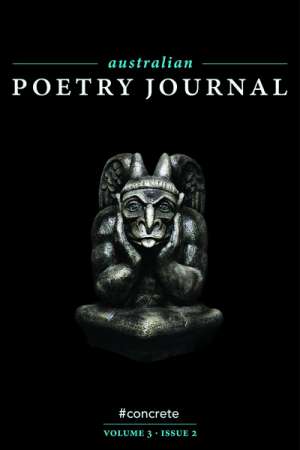Bronwyn Lea
Bronwyn Lea is Poet of the Month
Sunday, 26 February 2017Which poets have most influenced you? I first fell for the British Romantics: Keats for his sensitivity, and Byron for his humour, both qualities I try to exercise in my own work. Otherwise it’s the Americans of last century: the Moderns, Stevens in particular, and later the West Coast poets. I like to find these poets thinking (and sometimes running) in my poems.
... (read more)Jennifer Maiden's The Fox Petition: New Poems (Giramondo) conjures foxes 'whose eyes were ghosts with pity' and foxes of language that transform the world's headlines
... (read more)Des Cowley reviews 'Australian Poetry Journal', vol. 3 no. 2 edited by Bronwyn Lea
My first encounter with concrete poetry came via Apollinaire’s Calligrammes (1918), specifically his eye-catching poem ‘Il Pleut’. With its gently cascading words falling down the page, it was immediately clear that the typographic arrangement of the poem was of far greater import than its semantic content.
Although the term was not coined until the 1950s, concrete poetry draws upon traditions as diverse as ancient Greek shaped poems, Lewis Carroll’s ‘The Mouse’s Tale’, and the typographic experiments found in early twentieth-century Dada and Futurist publications. Despite this, concrete poetry has historically fallen between the cracks of various critical discourses. Is it art or is it poetry?
... (read more)Seen through one window, Paul Hetherington’s Six Different Windows appears to be a collection of poems concerned with the death of art. Such a theme is perhaps not surprising given that Hetherington, in addition to his seven books of poems, edited three volumes of Donald Friend’s diaries for the National Library of Australia, the last of which was shortlisted for a Manning Clark House National Cultural Award in 2006.
... (read more)A novel that can be summarised in a single, captivating sentence is a publisher’s dream. Not that ease of marketing is a reliable measure of excellence. Virginia Woolf’s To the Lighthouse (1927), for instance – which could be described as ‘the story of a mother who dies before taking her son to visit a lighthouse, and later a woman completes a painting’ – achieved classic status despite an unpropitious précis. Woolf’s genius aside, it is difficult to imagine a sentence like that sparking an international bidding war of the kind that erupted last year over Hannah Kent’s first novel. Burial Rites – ‘the story of the last woman to be beheaded in Iceland’ – reportedly netted Kent a considerable advance.
... (read more)Cassandra Atherton reviews 'Australian Poetry Journal, Volume 2, Issue 2' edited by Bronwyn Lea
Australian Poetry Journal, the flagship publication of Australian Poetry, contains a veritable who’s who of Australian poets. However, this doesn’t mean that the journal is part of the poetry gangland to which some other contemporary Australian journals belong. This is a testament to editor, Bronwyn Lea, who must disappoint many poets – possibly even poet friends or acquaintances – in order to maintain the journal’s impressively high standard. While there are a bevy of famous names on the contents page, Australian Poetry Journal only publishes the best work from these poets and scholars. But it is not just a journal for established poets and poems; emerging poets Davina Allison and Carmen Leigh Keates effloresce in this vaunted company.|
... (read more)W ordsworth – poet–walker par excellence – had the best legs in the business. As his friend Thomas de Quincy noted: ‘Undoubtedly they had been serviceable legs beyond the average standard of requisition. For I calculate, upon good data, that with these identical legs Wordsworth must have traversed a distance of 185,000 English miles.’ In contrast, Simon Armitage’s legs, by his own admission, generally ‘do very little other than dangle under a desk’ or propel him from the multi-storey car park to the railway ticket office. ‘Even if I’m writing about the Sahara or the Antarctic,’ he confesses, ‘I’m usually doing it in a chair, in a room, behind double glazing.’
... (read more)Rose Lucas reviews 'Australian Poetry Journal Volume 2.1 technology' edited by Bronwyn Lea
Australian Poetry Journal, the biannual publication published by Australian Poetry, offers a national focus for poetry and criticism. It includes contributions from established writers and from new voices. All in all, APJ indicates a cheering and cohering centre of gravity for all things poetic in contemporary Australia.
... (read more)Broadly speaking, there are two types of epitaphs: those formulated by loved ones to describe the living qualities of the interred; and those that would presume to speak from the grave. Writers, ever reluctant to pass up a blank page – even if it is a tombstone – are disproportionate constituents of the latter ...
... (read more)Everyman’s Rules for Scientific Living was always going to be a tough book to follow. Carrie Tiffany’s début novel, published in 2005, was shortlisted for various major prizes, including the Miles Franklin Literary Award and the Orange Prize. It also won the Western Australian Premier’s Book Award in 2005 and the Dobbie Literary Award in 2007. Everyman’s Rules tells the story of a sewing instructor and a soil scientist who meet aboard the ‘Better Farming Train’ as it passes through the Victorian countryside, and who settle in the impoverished Mallee farmland.
... (read more)








